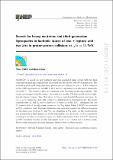Search for heavy neutrinos and third-generation leptoquarks in hadronic states of two τ leptons and two jets in proton-proton collisions at s = 13 √s=13 TeV
Author(s)
The CMS Collaboration
DownloadPublished version (713.1Kb)
Terms of use
Metadata
Show full item recordAbstract
© 2019, The Author(s). A search for new particles has been conducted using events with two high transverse momentum τ leptons that decay hadronically and at least two energetic jets. The analysis is performed using data from proton-proton collisions at s=13 TeV, collected by the CMS experiment at the LHC in 2016 and corresponding to an integrated luminosity of 35.9 fb −1 . The observed data are consistent with standard model expectations. The results are interpreted in the context of two physics models. The first model involves right-handed charged bosons, W R , that decay to heavy right-handed Majorana neutrinos, N ℓ (ℓ = e, μ, τ), arising in a left-right symmetric extension of the standard model. The model considers that N e and N μ are too heavy to be detected at the LHC. Assuming that the N τ mass is half of the W R mass, masses of the W R boson below 3.50 TeV are excluded at 95% confidence level. Exclusion limits are also presented considering different scenarios for the mass ratio between N τ and W R , as a function of W R mass. In the second model, pair production of third-generation scalar leptoquarks that decay into ττbb is considered, resulting in an observed exclusion region with leptoquark masses below 1.02 TeV, assuming a 100% branching fraction for the leptoquark decay to a τ lepton and a bottom quark. These results represent the most stringent limits to date on these models.[Figure not available: see fulltext.].
Date issued
2019Department
Massachusetts Institute of Technology. Department of Physics; Massachusetts Institute of Technology. Laboratory for Nuclear ScienceJournal
Journal of High Energy Physics
Publisher
Springer Science and Business Media LLC